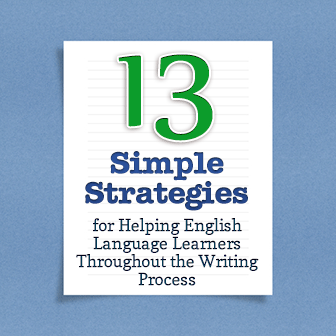Up, Down and All Around: 3 Editing Strategies for Your ESL Students


Because of that spoken-written word connection, engaging these skills in your ESL students when they write will help them move smoothly through the writing process. By helping your students engage the oral and aural skills they have acquired in their studies of English, they will find that writing is not as impossible as it might otherwise seem.

Prewriting is the stage of the writing process when the writer generates ideas for his writing. For ESL learners, this is also an opportunity to generate vocabulary and grammatical structures that will be necessary for writing on a particular topic. At times, your students will be more successful in groups. Other times they may need your assistance as they generate their ideas. You may find at times your direction is enough to set them going in the right direction, and then they will be able to work independently. They key is to be flexible and read your students. Here are some things you can do to get the writing process started.
Ask questions to help elicit vocabulary or grammatical structures from your students. This will engage their speaking abilities as it gets them thinking, too.
Work together as a class to create a word bank that relates to the topic on which they will write. You may choose to display these work banks in your classroom or encourage your students to keep them in a vocabulary notebook.
When lower language proficiencies may inhibit your students’ ability to articulate ideas, sidestep the issue by asking students to draw pictures of their ideas. They will later use these pictures, rather than notes, when they write.
Giving your students a blank template to organize their writing ideas may be just enough to get them going. Model filling one out, and then see what they can do as they make a plan for what they will write.
Doing research on the web, in books or with interviewees may be what your students need to find useful vocabulary or to determine the correct format for answering a question. Give your class time to prepare before they sit down to write especially if you are giving essay questions on content material they have learned.

In the second stage of the writing process, students will take the ideas they generated in the first step and start putting them into their logical positions in what will become their composition. Again, giving your students a chance to speak and prepare for writing is the key. Try any of these strategies in the organization phase.
Ask your students to choose one or more ideas they generated in the prewriting stage. Then have them write one sentence that introduces that idea to their readers. Explain to them that this is a topic sentence, which they can use to start a paragraph in their written pieces. Then have them organize any information about that topic under that sentence. When it is time to write, they will include that information in the paragraph with that topic sentence.
Let your students think outside the words and put their ideas into place on the physical page. Using a flow chart, bullet point lists, bubble map or other organizers that show the relationship between ideas, have your students lay out their thoughts on the physical page. When it is time to write, they simply follow their ideas along the page.
Asking your students leading questions or open ended questions will help them flesh out their ideas before they begin to write. When students have chosen a topic, penguins for example, challenge them to answer questions that begin with the journalistic words (who, what, where, when, why, how). Who studies penguins? What do penguins eat? How do they spend their time? Where do they live? Why do penguins do the things they do? If you have pairs of students ask each other these types of questions, they will get the double benefit of conversation and grammar practice while they are organizing their ideas.

When your students enter the writing phase of the five step writing process, make sure they understand that a draft is not the final composition. When students strive for perfection in a written draft, the result is often paralysis. Instead, remind your class that writing is a process, and they will have an opportunity to find and correct their errors later in the process. Right now, their goal is to get something written out on the page.
Using a fill in the blank template for topic sentences, thesis statements and transitions may help your students as they write the first draft of their essays. When you give them the grammar and the organization, they can put all of their energy into the content as they write.
Similarly, students working off the graphic organizers and templates they used in the organization stage will have a more thorough grasp of the vocabulary and content that they will need to write at this stage.

In the editing process, writers look for major communicative gaps in their essays. When your students edit their compositions, encourage them to pay attention to writing elements such as thesis statements, content development, introductions and conclusions.
Peer editing is one of the best resources for ESL students at this point in the writing process. Assigning a partner to each student and asking that person to look for specific issues in the essay can be a priceless experience for your students. Encourage each person to look for any breakdown in meaning, confusion in organization, or topics that are not fully addressed in the composition.

Rewriting is just as important as the rest of the steps in writing a complete piece. Here your students will look for errors in grammar, sentence structure, word choice, spelling and punctuation.
Dictionaries are a tremendous resource for ESL students. Whether they use a bilingual dictionary or an English only version, checking for spelling and misuse of words or word forms can be done here.
This is also a good time to look at the sentence structure your students are using most often. Likely, they will be relying too heavily on simple sentences, so a quick grammar review on combining sentences with coordinating conjunctions and using relative clauses is perfect to introduce here.
When you encourage speaking, language use, vocabulary development, and grammar examinations, your students will find that the process of writing may not be as intimidating as they once thought it was!
How have you used communicative activities in writing lessons?